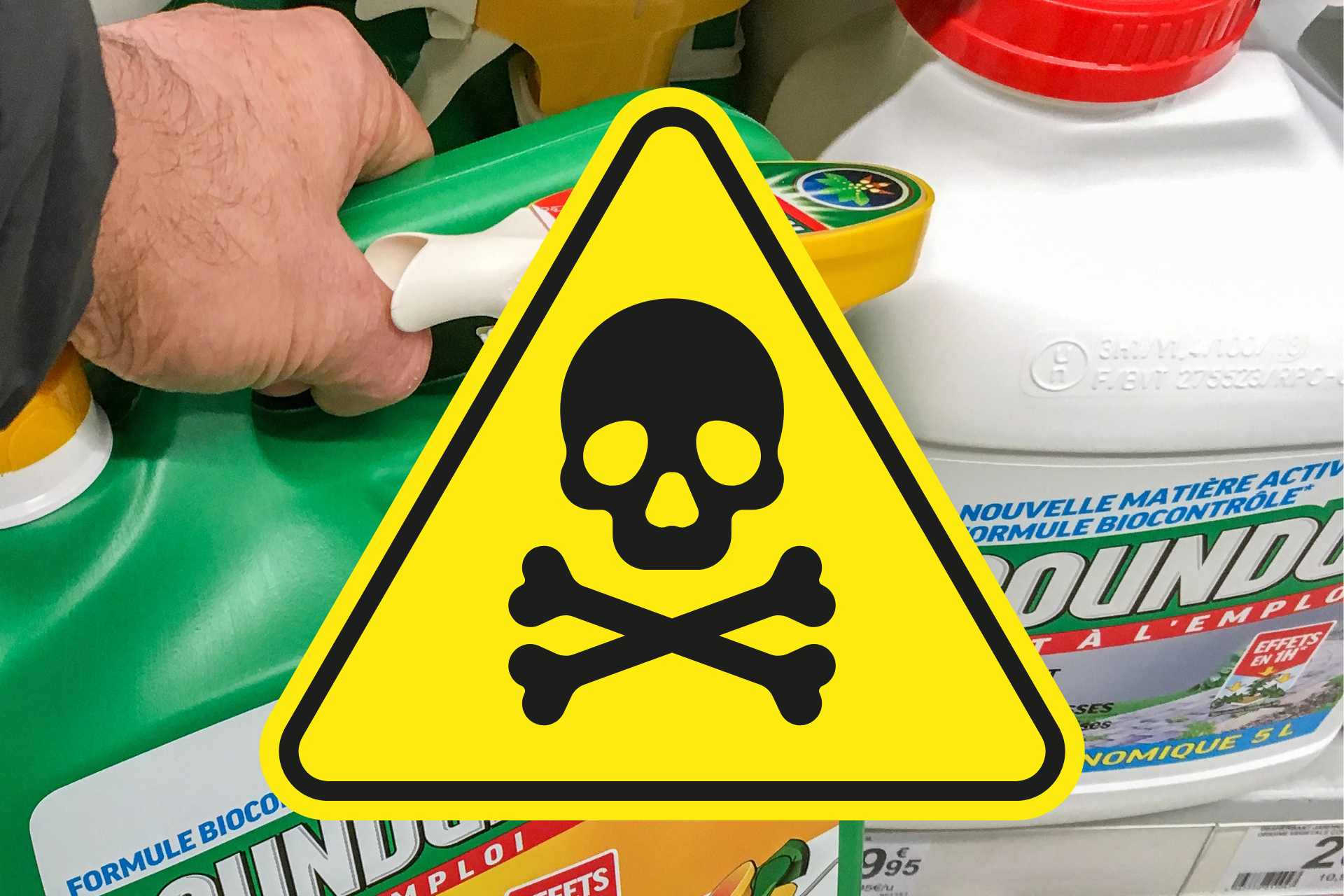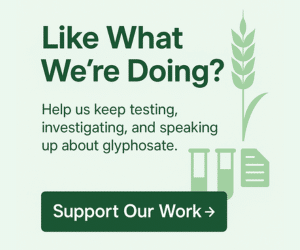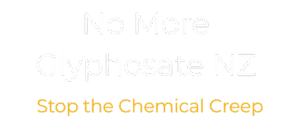By law, glyphosate is officially classified as a hazardous substance in New Zealand.
The Hazardous Substances and New Organisms Act 1996 (HSNO) — our core chemical safety law — recognises glyphosate’s toxic and ecotoxic risks. On paper, that puts it in the same legal bucket as bleach, petrol, drain cleaner, and fly spray.
So why don’t consumers see the same bold warning labels on glyphosate-based products? Why is Roundup — arguably more toxic than glyphosate itself — sold in glossy bottles with pictures of lush gardens and smiling homeowners, rather than skulls, crossbones, and hazard diamonds?
The answer lies in a regulatory gap that treats glyphosate as the hazard but downplays the cocktail of chemicals that make up Roundup and similar products.
What HSNO says: Hazardous, no question
HSNO is clear: any substance with toxic, corrosive, flammable, or ecotoxic properties is covered. Glyphosate meets those criteria. That’s why it sits on EPA’s official register as a hazardous substance.
Other household products carry the consequences of that classification. Bleach bottles come plastered with hazard icons. Petrol pumps shout “flammable.” Even dishwasher tablets warn of chemical burns.
Yet walk into Mitre10, Bunnings, or The Warehouse and you’ll find Roundup bottles promising quick, easy weed control with little hint of danger beyond fine print about “avoiding spray drift.” The legal label obligations feel more like marketing spin than consumer protection.
“Some days, it feels like the EPA has forgotten what the P stands for.”
Roundup is not glyphosate
Here’s where the disconnect sharpens.
- Glyphosate is the active ingredient, tested in isolation in laboratory settings.
- Roundup is a formulation: glyphosate mixed with surfactants, solvents, and adjuvants designed to help it penetrate plant cells.
Those added ingredients matter. They’re not inert. In fact, research has repeatedly shown that Roundup is more toxic than glyphosate alone — particularly to human cells, amphibians, and aquatic life.
One French study found Roundup formulations to be up to 1,000 times more toxic to human cells than glyphosate by itself. The surfactant POEA (polyethoxylated tallow amine), once common in Roundup, is especially damaging to aquatic organisms and has been restricted in Europe.
Yet in New Zealand, hazard assessments and regulatory decisions lean heavily on glyphosate-only data. The co-formulants that increase toxicity slip under the radar.
The hidden half of Roundup
While glyphosate is declared on the label, most Roundup products are mostly “other ingredients” — solvents, surfactants, stabilisers — whose identity is not disclosed to consumers. Companies cite “commercial sensitivity” and trade secrets.
The result? At the point of purchase, you don’t really know what’s in the bottle. Independent studies have found that the so-called “inerts” can magnify toxicity, sometimes making Roundup far more harmful than glyphosate alone.
We’ve covered this before in depth:
- The Hidden Dangers of Roundup: Why ‘Inert’ Ingredients May Be More Toxic Than Glyphosate shows how additives like surfactants may be up to 1,000 times more toxic to human cells.
- Why Roundup® Is More Dangerous Than Glyphosate Alone explains the regulatory blind spot in focusing only on glyphosate.
- Roundup® Exposed: The Chemical Cocktail Behind Glyphosate’s Mask breaks down how the undisclosed cocktail undermines claims of safety.
In other words: glyphosate is hazardous by law, but Roundup’s true composition — and its full hazard profile — remain hidden from public view.
Hazardous substances in disguise
The irony is hard to miss.
- Bleach: big black “Poison” label.
- Fly spray: bold warnings about inhalation.
- Drain cleaner: skull-and-crossbones.
- Roundup: green labels, sunshine, and claims of being “trusted worldwide.”
On paper, Roundup products are approved under HSNO as hazardous substances. In practice, their consumer-facing warnings are minimal — often nothing more than advice to “avoid contact with skin and eyes” or to “keep out of reach of children.”
For something classified in the same legal category as bleach, that’s an astonishingly light touch.
Everyday exposures: who really bears the risk?
This isn’t an abstract regulatory quibble. It’s about real-world exposure.
- Farm workers spray crops pre-harvest — wheat, barley, oats, peas — to dry them before harvest.
- Council contractors blanket roadsides, playgrounds, parks, and sports fields.
- Home gardeners spray fence lines, driveways, and vege patches.
- School grounds are still routinely treated by contractors, often without parents or teachers realising.
The people most exposed to glyphosate-based products are not lab technicians with protective gear. They’re workers, children playing on grass verges, and homeowners in jandals spraying weeds.
Shouldn’t the hazard messaging reflect that reality?
The regulatory gap
Here’s the crux:
- Glyphosate is a hazardous substance by law.
- Roundup products are approved as hazardous formulations.
- But hazard labels and public communication are diluted, leaving the public in the dark.
Why? Because EPA and other regulators largely rely on active ingredient data (glyphosate) when setting risk profiles. The co-formulants that tip Roundup into a more dangerous category aren’t fully accounted for in hazard classification or in retail warning labels.
In other words: Roundup is hazardous by law, invisible by label.
International contrasts
New Zealand is not alone in this gap — but other jurisdictions are starting to move.
- The European Union has restricted certain surfactants (like POEA) after evidence of their added toxicity.
- Several countries (France, Germany, Austria) are phasing out or banning glyphosate-based formulations in public spaces or altogether.
- In the United States, court cases have forced disclosure of internal Monsanto documents showing awareness of Roundup’s added toxicity.
Meanwhile, New Zealand clings to the narrow view: glyphosate is the benchmark, formulations are variations on the theme, and warning labels remain marketing-friendly.
Why this matters now
The recent High Court judgment on ELI’s attempt to force a reassessment of glyphosate showed just how tightly EPA clings to its current evidence framework. The Court didn’t rule glyphosate safe; it ruled that EPA’s process in saying “no reassessment grounds” was lawful.
That leaves us here: with glyphosate acknowledged as hazardous, Roundup arguably more toxic, and a retail environment where neither reality is honestly conveyed to the public.
Where this leaves us
It’s time to call this what it is: a double standard.
If bleach, petrol, and drain cleaner deserve hazard diamonds and clear warnings, then so does Roundup. If Roundup is demonstrably more toxic than glyphosate, then hazard assessments and labelling should reflect that reality — not gloss over it.
At the very least, the public deserves clear warning labels that match the product’s classification. And at best, we need a full reassessment of glyphosate-based weedkillers — not just the active ingredient in isolation, but the real-world formulations people are actually exposed to.
Because hazardous by law and invisible by label is not a standard that protects anyone.
Where This Leaves Us
The EPA can keep saying glyphosate doesn’t meet the bar for reassessment. But every bottle of Roundup on a hardware store shelf tells a different story: it’s legally hazardous, it’s more toxic than its active ingredient alone, and yet the people most exposed are left in the dark.
That’s not just a gap in regulation. It’s a gap in honesty.
Resources & References
When regulators insist glyphosate is “safe if used correctly,” it pays to check the fine print — and the sources they lean on. The following references aren’t just background reading; they reveal the tension between what the law recognises, what the labels admit, and what independent researchers are uncovering.
Glyphosate weedkiller – Find out how to safely use glyphosate in the garden.
Environmental Protection Authority (EPA)
Provides the regulator’s overview of how glyphosate is used in New Zealand (households, roadsides, farms) and emphasises that it is a “hazardous substance … regulated.”
Glyphosate rules and regulation
Environmental Protection Authority (EPA)
Lays out the legal framework under the Hazardous Substances and New Organisms Act 1996 (HSNO) for glyphosate and glyphosate-containing products: approvals, controls, label/packaging rules, etc.
Glyphosate in Aotearoa New Zealand [PDF]
Environmental Protection Authority (EPA)
(Call-for-Information Summary Report May 2022)
A summary of public responses to EPA’s call for information on glyphosate use and effects in New Zealand — valuable for understanding what data gaps the regulator acknowledges.
Glyphosate in food
Ministry for Primary Industries (MPI)
Outlines how glyphosate is regulated in food-chains: residue limits (MRLs), testing of crops and food items, and the relationship between EPA/ACVM/food-safety regulation in NZ.
Challenging the EPA’s regulatory failure on glyphosate
Environmental Law Initiative (ELI)
A campaign and legal-action page documenting ELI’s case that New Zealand has never done a full risk assessment of glyphosate and its formulations; useful for framing the argument of regulatory gap.
EPA finds no grounds to reassess glyphosate
Scoop News
A clear media summary of EPA’s July 2024 decision that there were “no grounds” for reassessment of glyphosate — which is central to your article’s argument.
Thousands submit on proposed increase in glyphosate weedkiller allowed on some crops
RNZ
Highlights recent public reaction to changes in glyphosate residue levels for crops in New Zealand, showing the growing controversy around tolerance/limits.
Glyphosate Health Risks: Who’s Responsible?
NoMoreGlyphosate.nz
An article from your campaign site that frames the regulatory “blind spot” on exposure, co-formulants, and worker/public safety — aligns directly with your message.
Taken together, these resources show a pattern: glyphosate and Roundup are hazardous enough to be tightly regulated on paper, yet their dangers remain largely invisible at the consumer level. The gap between regulation and reality is where trust breaks down — and where public vigilance becomes essential.
Image Source & Attribution
We’re grateful to the talented photographers and designers whose work enhances our content. The feature image on this page is by Pixavril with additional editing using canva.com.




